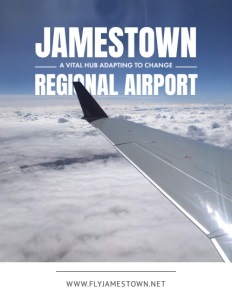Jamestown Regional Airport
A Vital Hub Adapting to Change
Investing in future-ready infrastructure to connect, fuel and serve its community
Jamestown Regional Airport, a bustling hub, serves as a critical connection point for the community and the surrounding region. As a part 139 commercial service airport, it boasts a versatile operation accommodating everything from commercial flights to general aviation. Katie Hemmer, the Airport Director, elaborates on the airport’s diverse functionality: “We have one commercial operator, United Airlines, operated by SkyWest with flights to Denver. Then we have industrial tenants that are manufacturing-based and general aviation.” The general aviation scene includes various activities, from agricultural spray plane operations to the Civil Air Patrol and various private pilots utilizing the airport’s facilities.
In hangar space, demand outpaces supply. “Our hangars are all occupied at this time,” Hemmer notes, indicating the airport’s strong activity level. The airport leases out eight T-hangars, but most hangars are privately owned, with owners leasing land from the airport. “We do have a couple of larger hangars that are privately owned,” she adds, “but they get to choose how many aircraft to store. Some could fit four or five planes, but they might only house one or two.”
Regarding runway capacity and maintenance, Hemmer describes a robust infrastructure ready to handle commercial air traffic demands. “Both runways are part 139 certified and approved for commercial aircraft,” she explains. The primary runway, designated 13/31, is the main artery for the CRJ 200 aircraft serving the airport, accommodating up to 50 passengers. Maintenance is also on task, with recent upgrades ensuring safety and efficiency. “We just did a full rehabilitation of the main runway this summer,” Hemmer reports. The project involved extensive milling and overlay work, major crack repair, and fresh grooving and painting, all completed just two weeks ago.

Industry Challenges and Local Solutions
The aviation industry faces significant headwinds, particularly for regional airports like Jamestown. Hemmer discusses the realities they contend with daily, especially the ripple effects of the pandemic on labor shortages.
“SkyWest, our carrier, was probably impacted the most post-COVID,” she says. While North Dakota implemented travel restrictions during the pandemic that initially reduced boardings and flights, the area saw a rapid rebound. However, the nationwide pilot shortage hit regional airlines the hardest. Hemmer explains, “SkyWest did not lay off any pilots during the pandemic, but when travel returned, many of their pilots had opportunities to move to larger carriers.” The pilot deficit, long predicted in the industry, was accelerated by layoffs and early retirements tied to the pandemic’s upheaval.
For Jamestown, this shortage is immediate. “It really affects our flight schedule so that we can’t have ideal departure and arrival times,” Hemmer notes. The airline can only run overnight aircraft in North Dakota with adequate crew availability, a limitation that affects both boardings and the community’s ability to make desired connections. “We’ve definitely seen an impact on our boardings,” she continues, tying these operational constraints to the broader pilot shortage crisis.
Addressing the issue of pilot training and maintenance services, Hemmer highlights the airport’s proactive efforts. “Our fixed base operator offers flight training and partners with the high school,” she shares. Although collaboration with the local university has yet to take root, the introduction to aviation class offered at the high school provides the ground school portion of pilot training. This creates a seamless pathway for students interested in aviation, allowing them to transition smoothly into actual flight training. “We can do our part from Jamestown to help supply that pilot shortage,” Hemmer emphasizes.
The airport’s approach to career development doesn’t stop there. Hemmer points out that North Dakota’s long-standing low unemployment rates necessitate early career introduction across various fields. This strategy aims to guide students into paths like piloting before they commit to post-high school training, recognizing that becoming a pilot doesn’t necessarily require a four-year degree. “Getting those students involved before they make that decision for post-high school training helps them decide if this is a career path they want to move on,” Hemmer notes.
The airport collaborates with several entities for maintenance and operational services. First Class Aviation, the airport’s fixed-base operator, handles fueling, flight training, aircraft rental, and some storage capabilities. Hemmer specifies, “This particular fixed-base operator is not the mechanic. We do have one separate operation that does offer mechanic services at the airport.” That operation, High Plains Aviation, leases space on the airport grounds and coordinates with First Class Aviation, though they remain separate businesses.
A Hub of Economic Activity
Jamestown Regional Airport plays a pivotal role in the region’s economy, serving as a transit point and a critical economic engine. Hemmer believes the airport is “a gateway to the community” and substantially influences local economic development. The airport’s accessibility is vital for significant employers whose headquarters or ownership aren’t based in Jamestown. “Many of our major employers utilize the airport, especially for upper management and ownership visits to the community,” she says, indicating that this convenient access supports operational efficiency and business growth.
The airport’s commercial service also helps reduce the need for residents to travel to bigger cities for flights. “We help retain some of those dollars that would have leaked out of our community,” Hemmer notes, explaining how these retained dollars circulate within Jamestown, contributing to the local economy. Additionally, the airport’s presence makes the area more attractive. “Offering commercial airport services helps attract businesses that might not be owned locally but need to travel here,” she adds.
Further bolstering its role in economic development, the airport has partnered with the Jamestown Stutsman Development Corporation to develop over 80 acres of airport property. This initiative includes land designated for aviation use, offering potential business sites, logistics companies, and additional FBOs. “We have all the utilities put in, including the road, water, sewer, power, and natural gas,” Hemmer states, stressing that these sites are completely shovel-ready for businesses. In a competitive landscape where being “shovel ready” can make or break a site selection, this development positions Jamestown favorably for attracting new industry.

Supporting Tourism and Cultural Richness
While tourism is not the primary driver of air traffic, the airport still serves as a gateway to the unique attractions of Jamestown and the surrounding region. Hemmer admits that tourism isn’t the primary source of visitors, but many who come for business or to visit family often explore the area’s “authentic Midwest experiences.” From camping and fishing to hunting, the region offers a slice of rural America that’s both unique and accessible.
The city also offers attractions like the world’s largest buffalo—a massive concrete sculpture that has become a roadside icon. “It’s really fun to take your whole family up and do the picture with it,” Hemmer says with a smile. The site includes a Frontier Village, providing a glimpse into the Midwest’s pioneer past with recreated buildings like an old-time dentist shop and print shop. The National Buffalo Museum adds to the experience, chronicling the history of the bison and its role in Native American culture and the ecosystem.
Perhaps most uniquely, the museum grounds are home to a live herd of buffalo, including rare white bison. Hemmer recounts the story of how the herd gained its famed albino buffalo. “The original white buffalo that lived here was born to a rancher,” she explains. The animal’s rarity and popularity made it difficult for the rancher to manage the public interest, leading to its lease to the herd in Jamestown as a tourist attraction. Though the original albino buffalo has passed, she left behind two white calves, ensuring visitors can still witness these incredibly rare animals.
Upgrading Infrastructure and Enhancing Efficiency
As Jamestown Regional Airport adapts and grows, infrastructure improvements remain a top priority. Hemmer outlines several vital projects to modernize the airport and improve operational efficiency. One of the most significant undertakings this summer is the complete overhaul of the airfield lighting and electrical systems.
“We have upgraded all new lights and signs to be LED features,” she states. This upgrade includes the lights and the installation of all-new wiring housed in conduit—a significant improvement over the previous direct-bury method. In addition, the project involves a complete revamp of the electrical vault, encompassing new regulators and components crucial for airfield lighting operations.
From a visibility standpoint, this transition to LED lighting represents a major step forward. “The LED lights provide a great product for pilot visibility,” Hemmer notes, highlighting the intensity and clarity of the new lighting system. The benefits extend beyond enhanced visibility; the airport anticipates cost savings, too. “We should see a difference in our utility bills,” Hemmer explains, pointing out that LED lights consume less power and require fewer replacements, leading to decreased maintenance costs over time.
Hemmer also identifies snow removal equipment as another focal point for capital investment. In North Dakota, where winters are long and harsh, efficient snow removal is critical to maintaining airport operations. “We have upgraded some equipment in recent years, and we will be upgrading another piece of our major snow removal equipment,” she says. Specifically, the airport will replace a loader tractor carrying its largest snow blowers. With equipment becoming larger and more versatile—able to plow and spread deicer simultaneously—the need for expanded storage facilities has become pressing. “We will be expanding our snow removal equipment building,” Hemmer confirms, ensuring the airport remains well-equipped to handle winter conditions.
These projects illustrate Jamestown Regional Airport’s forward-looking approach, balancing immediate operational needs with long-term infrastructure planning. Through targeted upgrades and expansions, the airport is ensuring that it remains a vital, efficient link for the community and a seamless gateway for all who pass through its doors.
AT A GLANCE
Jamestown Regional Airport
What: A part 139 commercial service airport serving regional and general aviation needs
Where: Jamestown, North Dakota
Website: https://www.flyjamestown.net/
PREFERRED VENDORS
Jamestown Tourism – DiscoverJamestownND.com
Jamestown Tourism drives economic growth by promoting Jamestown, North Dakota, as a premier destination. Our efforts attract visitors, boosting local businesses and creating opportunities in hospitality, retail, and services. By showcasing iconic attractions like the World’s Largest Buffalo, we help fuel the region’s economy. Learn more at DiscoverJamestownND.com.



